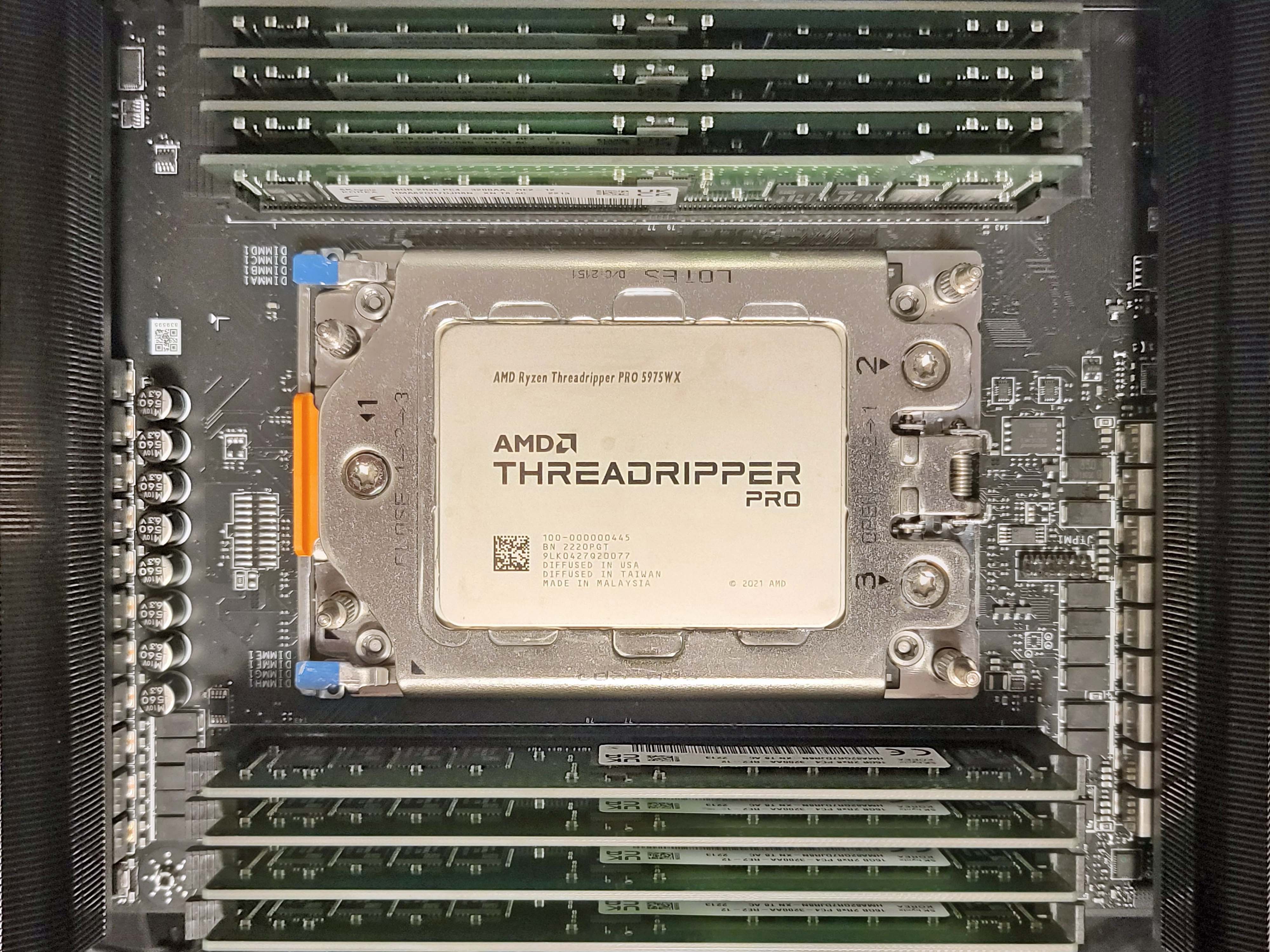Why you can trust Tom's Hardware
Desktop PC Application Benchmarks on Threadripper Pro 5995WX and 5975WX — The TLDR:


The above geometric mean of single- and multi-threaded performance only encompasses key workloads in our standard test suite for mainstream desktop PCs. We also have SPECworkstation 3, SPECviewperf 2020, and Adobe suite testing after our standard tests below.
Here, the Threadripper Pro 5995WX delivers class-leading threaded horsepower in our geometric mean of multi-threaded workloads. The 5995WX is 15% faster in threaded work than the previous-gen 3995WX, but bear in mind that the 5995WX is power-capped at 280W just like the 3995WX, so uncorking the power limits on a capable motherboard could extend that lead significantly. Unfortunately we can't test that due to the vendor locking we covered in the test setup section.
The 5975WX is 13% faster than its prior-gen counterpart, the 3975WX, in the multi-threaded tests but extends that lead to 22% after we remove the power limits with PBO. Overall, the Threadripper Pro chips take a comfortable lead over Intel in the threaded benchmarks.
As expected, consumer-focused chips still dominate our single-threaded rankings, with the Core i9-12900K being 30% faster than the 5975WX. The 5000-series Threadripper chips offer similar performance in lightly-threaded work, which isn't surprising given that they have the same 4.5 GHz peak boost clock. They are also roughly ~17% faster than the prior-gen Threadripper Pro models.
Rendering Benchmarks on AMD Threadripper Pro 5995WX and 5975WX






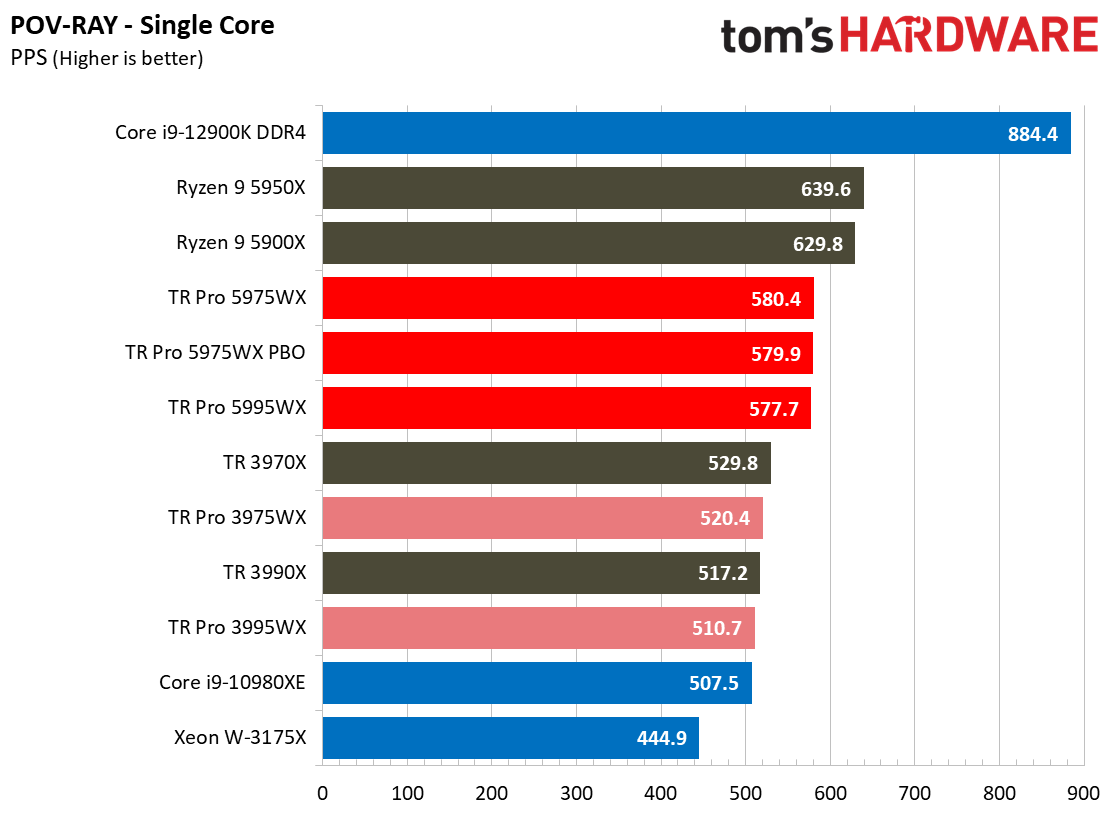




The rendering benchmarks land right in Threadripper Pro's target market. Cinebench has long been AMD's favorite benchmark for a simple reason; the Zen microarchitecture has always performed extremely well in the threaded benchmark. The 64-core 5995WX basically ties the previous-gen 3990X that we tested with a drastically better motherboard and cooler, so this might not be the peak performance you can expect from the 5995WX. The 5995WX is ~6% faster than the previous-gen 64-core Pro model, the 3995WX.
Flipping over to single-threaded Cinebench shows the 5000-series Pro chips delivering ~15% more performance than the prior gen. The consumer chips dominate the chart, though.
The POV-Ray multi-thread benchmark scales great across the 5995WX's 64 cores, granting it and the other 64-core chips the lead. The 5995WX is 23% faster than the 32-core 5975WX, but that's not a bad value proposition — the 5995WX costs nearly twice as much.
Get Tom's Hardware's best news and in-depth reviews, straight to your inbox.
The Threadripper chips trail the consumer chips in the single-core POV-Ray benchmark but slide past Intel's competing workstation-class chips again.
Intel's HEDT chips pull off a lone win in the PCMark 10 rendering and visualization subtest, but most of these threaded tests skew towards Threadripper.
V-ray and C-Ray expose some of the 5995WX's bipolar performance trends. The chip scales within expectations in v-ray, taking a 48% lead over the 5975WX and exhibiting nearly linear scaling. However, the C-Ray benchmark isn't optimized to span both processor groups, meaning only half of the 5995WX's cores come into play, giving the 32-core 5975WX the lead. There are techniques to sidestep these challenges, but professionals should carefully evaluate their workloads before dropping $6,500 on the 5995WX.
The Intel Open Image Denoise ray-tracing test uses Intel's oneAPI rendering toolkit. Hence, it provides an interesting take on performance that's more of an academic exercise than an indication of real-world performance — at least for now. OneAPI is still in the early days of development, not to mention adoption, but it is an interesting display of Intel's latest approach but in a decidedly Intel-friendly test. This test benefits from memory throughput, so the Xeon W-3175X shows its six-channel chops. Regardless, the eight-channel Pro chips take the lead.
Encoding Benchmarks on AMD Threadripper Pro 5995WX and 5975WX







Our encoding tests include benchmarks that respond best to single-threaded performance, like the quintessential examples LAME and FLAC, but the SVT-AV1 and SVT-HEVC tests represent a newer class of threaded encoders.
It's no surprise to find the consumer chips faring better than the Threadripper CPUs in LAME and FLAC, but the 5000 series have improved AMD's standing dramatically in single-threaded work.
The SVT-AV1 and SVT-HEVC benchmarks show that these threaded encoders respond well to increased core counts, which plays right into Threadripper's hands. However, the software doesn't appear to be entirely optimized for the 64-core Threadripper's unique architecture — the 32-core 5975WX leads in the HEVC benchmark. We also only see small deltas between the 32-core and 64-core in the AV1 benchmark.
Flipping over to HandBrake, we can see the Threadripper Pro chips leading the x264 and x265 tests, but it's important to note that these tests are of relatively short duration. We have longer-duration HandBrake tests in the SPECworkstation benchmarks below. Those workstation-tuned benchmarks expose bigger performance deltas.
Web Browsing, Office and Productivity on AMD Threadripper Pro 5995WX and 5975WX


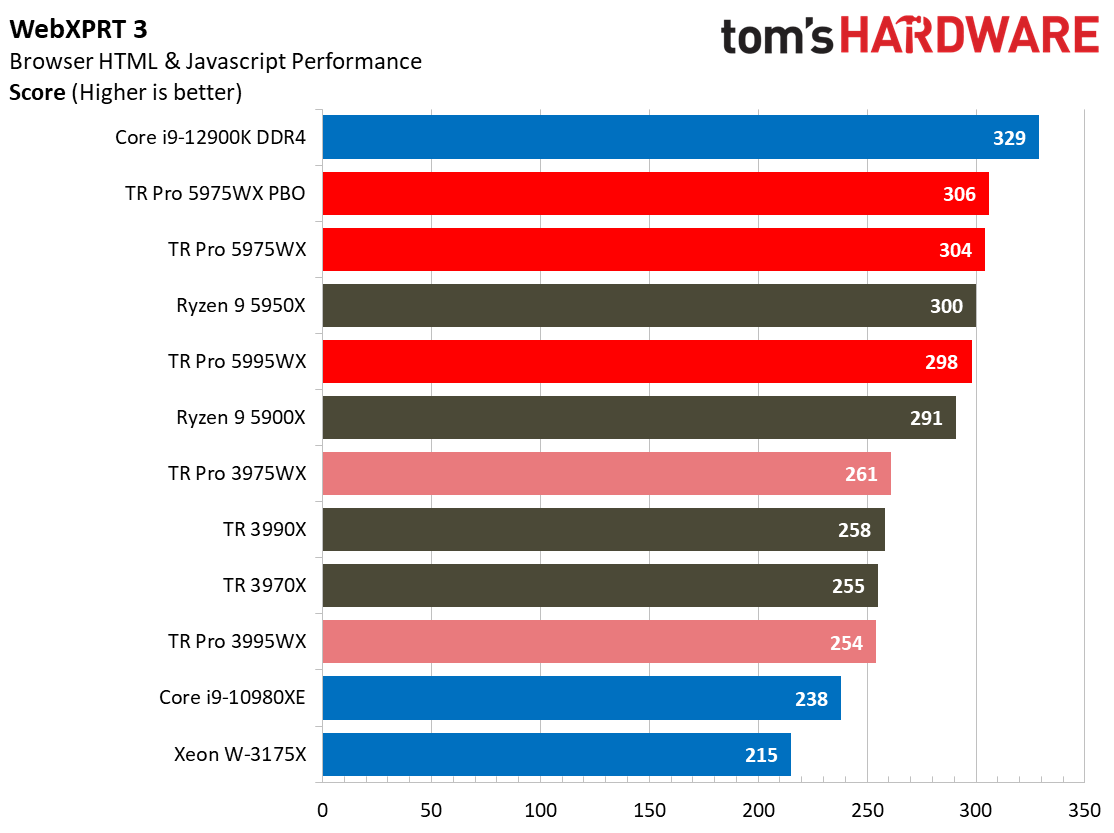




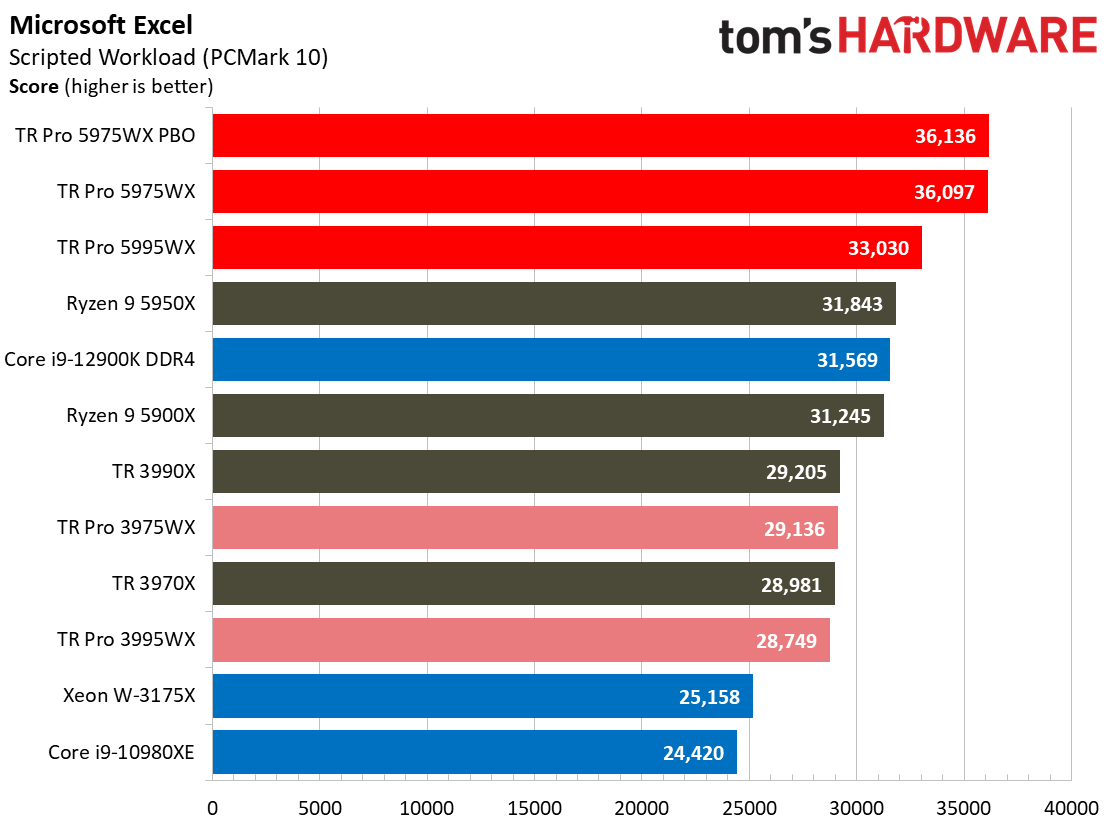


If you're looking to build a screaming-fast workstation, you're probably not doing it to run web browsers and office applications like Word at breakneck speeds. However, these types of applications are ubiquitous the world over, so snappy performance is important for daily tasks. We test the web browser benchmarks in a version-locked Chrome browser, with the notable exception of the Edge test.
Most of the web browser benchmarks are lightly threaded, so Intel's 12900K puts on a show with leading performance across the board. However, the Zen 3 architecture in the 5000 series processors has improved Threadripper's standing - the new Threadripper chips show tangible generational performance leads over the prior-gen models, thus often taking the second and third positions in the charts. We also see a similar result with the responsiveness benchmark, which measures load times in common desktop PC applications.
Compilation, Compression, AVX Performance on AMD Threadripper Pro 5995WX and 5975WX

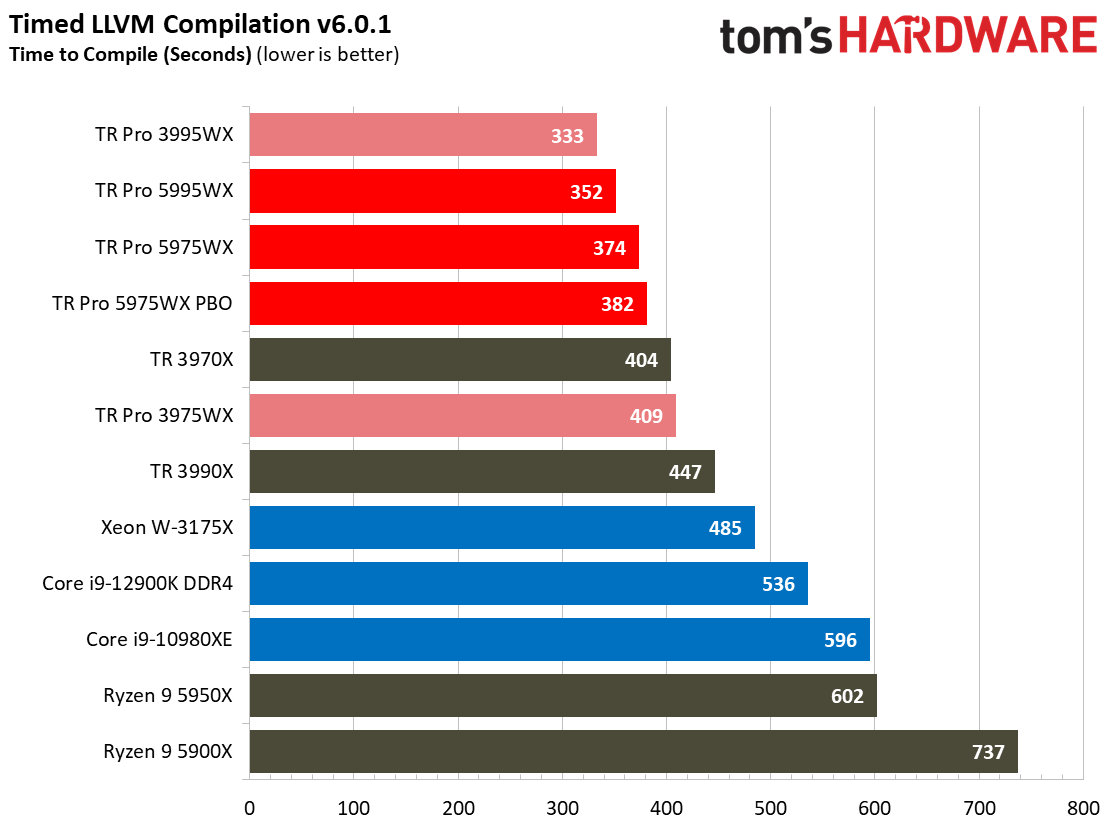



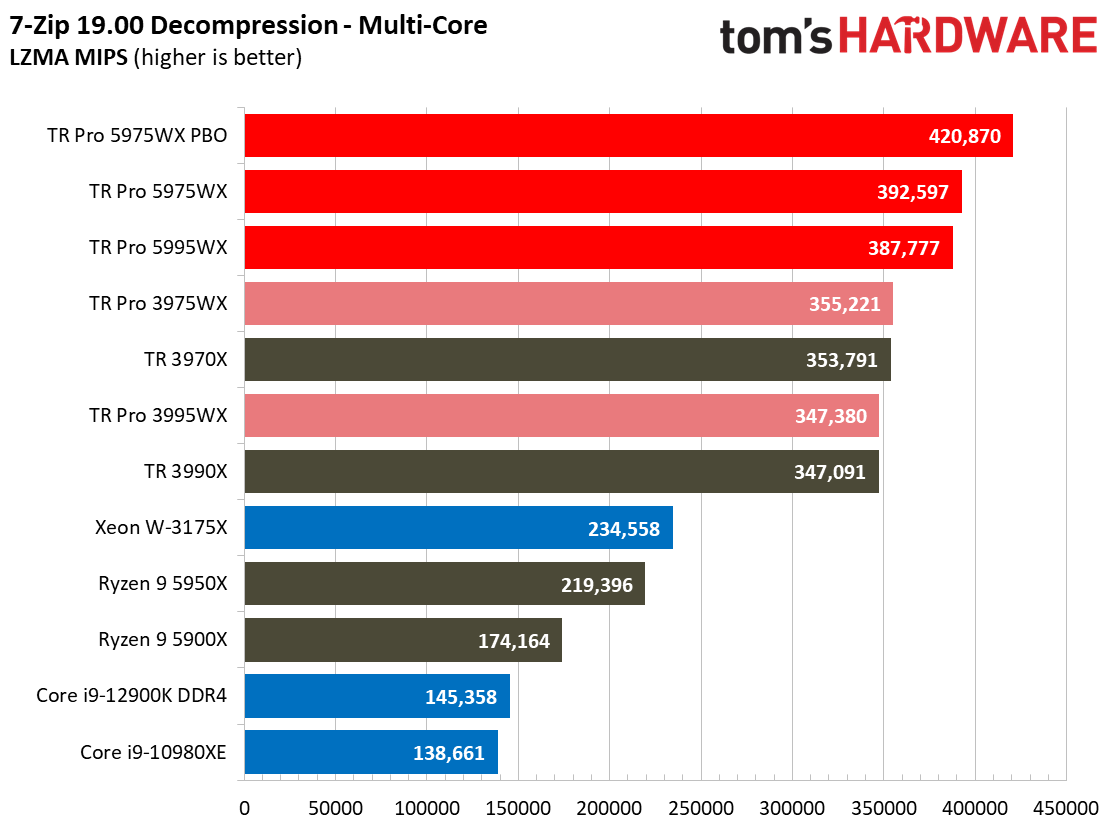


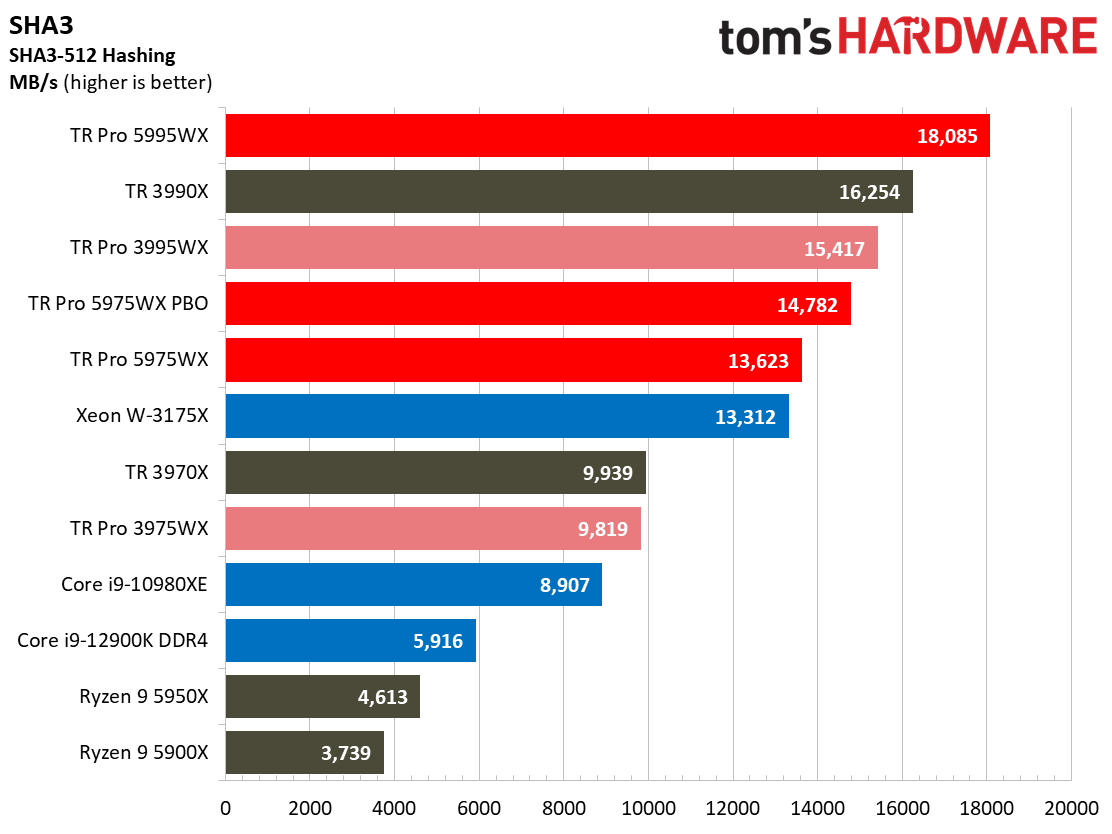
The Timed LLVM and NAMD benchmarks can't fully expose the parallelism of the 5995WX, resulting in sub-par scaling. We also see the 3995WX lead the 5995WX in the Timed LLVM compilation, implying some sort of odd interaction with the benchmark.
Our 7zip results are interesting, but this benchmark runs directly out of memory, giving the eight-channel Threadripper processors an unassailable lead. On the other hand, the y-cruncher benchmarks also operate from main memory, giving the Threadripper 5975WX the upper hand. However, the threaded test isn't of long enough duration to expose the full power of the 5995WX.
The AES, HASH, and SHAH3 tests scale wonderfully across the cores, giving the 5995WX the lead. The 5975WX performs much more admirably overall, but much of that is simply due to software issues with the 5995WX's prodigious core counts.
- MORE: AMD vs Intel
- MORE: Zen 4 Ryzen 7000 All We Know
- MORE: Raptor Lake All We Know
Current page: Desktop PC Application Benchmarks on Threadripper Pro 5995WX and 5975WX
Prev Page Gaming Benchmarks on Threadripper Pro 5995WX and 5975WX Next Page Workstation CPU and GPU Benchmarks on Threadripper Pro 5995WX and 5975WX
Paul Alcorn is the Editor-in-Chief for Tom's Hardware US. He also writes news and reviews on CPUs, storage, and enterprise hardware.
-
-Fran- I love the latching mechanism of sWRX8. They should consider using it in consumer as well. I mean, they're already going to ask for a pretty penny on the current one, so why not just make the mechanism the best in the industry?Reply
And this looks quite impressive, specially since these can also do games quite well it seems. I wonder if AMD will ever put a "mini-Milan-X" in sWRX8 for whomever can pay for it? XD
Regards. -
escksu I am hoping tomshardware could test on win11 or server 2022. This is because these 2 OS by default will allow apps to use all available threadsReply
https://docs.microsoft.com/en-us/windows/win32/procthread/processor-groups -
Wisecracker Snagged an OEM ThinkStation P620 Workstation 16 or so months ago from RTP for $2,400 with ...AMD Ryzen TR Pro 3945WXReply
32GB DDR4-3200 RDIMM ECC
Quadro P2200 5GB - 4x DP_1.4
Marvell 10Gb Ethernet
512 GB M.2 Gen 3 PCIe SSDBuilt software RAID with 1TB Samsung SSDs, updated softwares (primarily Vegas Pro) with Canon SLR stuff and fancy appurtenances. Will do a minute -- in 30 seconds.
Other than a !%$@!*^ noisy PSU fan, it has been bulletproof ___ BUT, our good friends at AMD are taking advantage of their captured market. OEM prices easily are up 50% ... -
Sylwah Not a great article: this is a workstation processor and you're leading with gaming benchmarks, and continue to mostly cover gaming.Reply
Then there's the Windows 10/11 discussion.
Please do better next time. -
Guy Rouillier "The problem is AMD has left the two lower-end 12- and 16-core Pro models as OEM-only, so they won't come to retail."Reply
NewEgg has the Threadripper PRO 5955WX available now for $1299:
https://www.newegg.com/amd-ryzen-threadripper-pro-5955wx/p/N82E16819113776
That's a pretty hefty entry price for a home system, but it is available. The quad channel memory of the 3000 series was also better matched to the enthusiast market; only servers and high-end workstations benefit from the 8-channel memory. But I understand AMD's position; they are supply-constrained, so might as well go for the highest-priced markets available. -
This is not an option for home DIY builders, unless they have more money than senseReply
This is a workstation class processor and this is what we use at work on our workstations with tons of RAM and lots of storage so we can run as many virtual machines at once as we need for software development and testing
Threadrippers are all we use. we don’t bother with intel because they have NOTHING to touch it -
Guy Rouillier ReplyMandark said:This is not an option for home DIY builders, unless they have more money than sense
I wouldn't necessarily disagree with that, given the cost of a complete system on this platform. I was also a professional software developer, now retired. The last system I built for myself around 2013, which I'm still using, is a dual AMD Opteron 4234 with 16 GB of memory and all SSD storage. If I were to build a new system today, it would be with Threadripper. Though as I mentioned, for software development 8 memory channels is overkill; 4 really was the sweet spot. I ran our complete runtime environment on my system: a DBMS (Oracle or PostgreSQL), a web server with a JavaEE stack, a JBoss app server, plus all my development tools (Eclipse, etc.)
So, there is still a need for powerful workstation-class systems for individual end-users, but the numbers are small compared to the overall size of the market.
